Animals with long necks come in all shapes, sizes, and different animal types. What unites them is the elongated cervix, some longer than others.
Want to know more about these animals? You’ve come to the right place!
Examples of Long neck animals include giraffes, ostriches, egrets, camels, vultures, horses, and many more. Some of these animals have gone extinct, others remain in existence today.
Let’s take a look at a list of 30 animals with long necks in the world, and see what we can learn about them.
List of Long Neck Animals
1. Giraffe
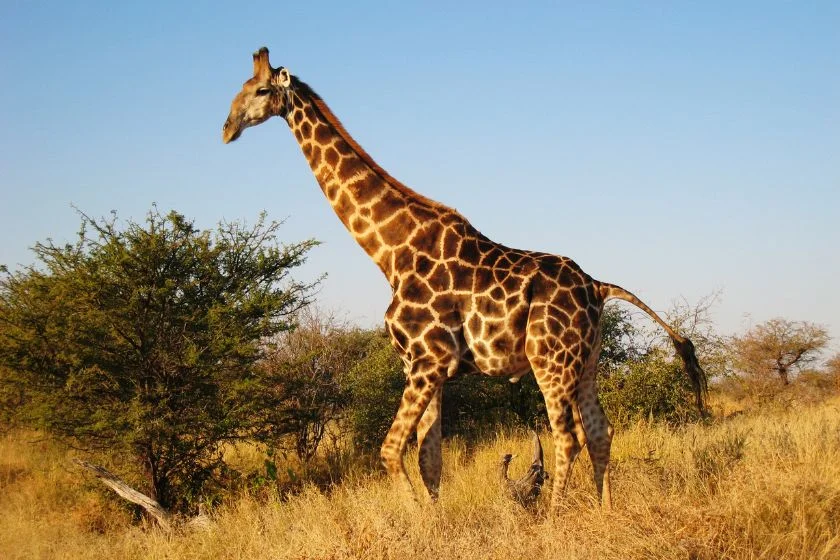
- Scientific Name: Giraffa Camelopardalis
- Size: 14 to 19 feet tall
- Range: Africa
- Habitat: Savannah, Woodlands
- Diet: Herbivore
- Conservation Status: Vulnerable
The giraffe is the world’s tallest land-living mammal, and it could only achieve this feat because of its unusually long neck.
A giraffe is capable of reaching leaves on tall trees but finds it very difficult to drink from a lake or river.
Its neck falls between 6 and 8 feet long, making it the extant animal with longest neck.
The giraffe has a positive relationship with humans as they symbolize many good qualities like grace, beauty, and feminity. It has also been a subject of much African art, as well as movies and cartoons.
However, the giraffe is also a target for hunters. Because of hunting and habitat decline, the giraffe population has dwindled. It is currently considered vulnerable.
2. Ostrich
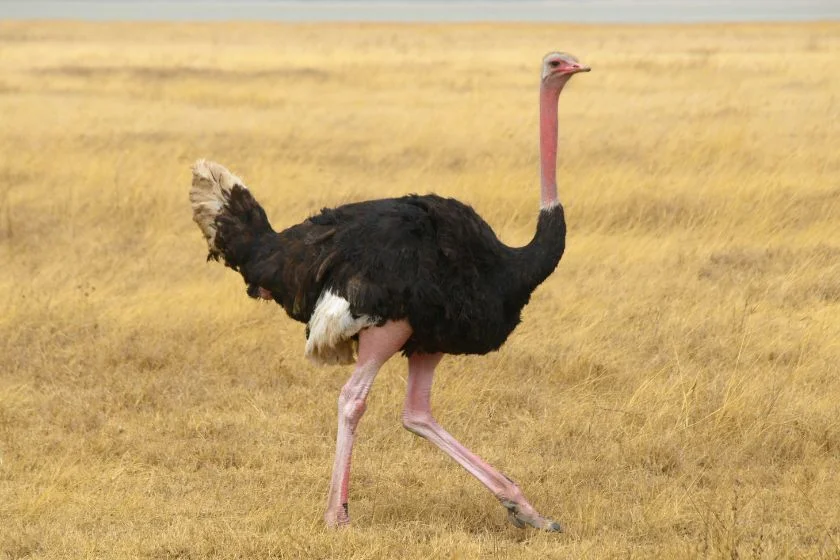
- Scientific Name: Struthio camelus
- Size: 1.7 to 2 m
- Range: Africa
- Habitat: Savannah, open woodland, grassland
- Diet: Omnivore
- Conservation Status: Least Concern
The ostrich holds the record of being the fastest bird in the world and also has the biggest egg a living land animal can have.
There are two ostrich species in existence today: the common ostrich and the Somali ostrich. Both are found in Africa where they inhabit savannas, grasslands, and open woodlands.
The ostrich neck is one of the longest you’d find among birds. Though this bird can’t fly, the ostrich’s speed made up for that.
The neck is advantageous in that it helps the ostrich pick food that’s far away from it, and gives it a better chance of detecting predators.
3. Camel

- Scientific Name: Camelus dromedarius
- Size: 7 to 12 feet long, 5 to 7 feet tall, and weigh 880 to 1,320 pounds
- Range: Middle East, China, Mongolia
- Habitat: Desert, prairie, steppes
- Diet: Herbivore
- Conservation Status: Domesticated, Critically endangered
There are currently three camel species still in existence. The first is the dromedary, which is the most popular camel species with 94% in existence. It is also called the Arabian camel or the one-humped camel.
The Bactrian camel has two humps instead of one, and it makes up 6% of the camel population. The third group is the wild Bactrian camel which is critically endangered.
The camel is currently a domestic animal, living in different parts of Asia. It is a good form of transportation across the desert and is popular amongst people living in arid regions.
The camel has a long neck that helps it reach the ground as it feeds on plants.
4. Gerenuk
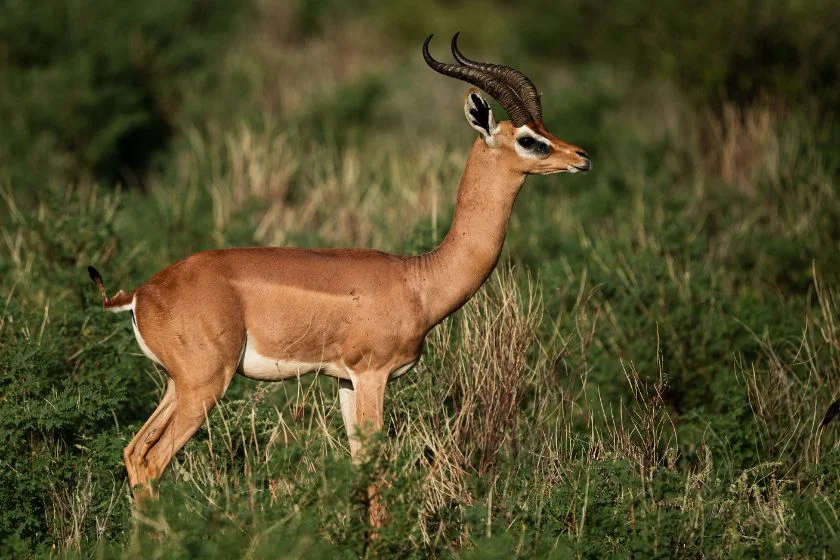
- Scientific Name: Litocranius walleri
- Size: 2 feet 7 to 3 feet 5 inches tall, 40 and 115 pounds
- Range: Africa
- Habitat: Dry lands, desert, woody vegetation
- Diet: Herbivore
- Conservation Status: Near Threatened
The gerenuk, also known as the Waller’s gazelle and the giraffe gazelle, is located in Africa. It has the looks of a regular gazelle, except for the neck length.
Its neck is long—about 7–10 inches—as well as the limbs. The Gerenuk can easily reach tall vegetation compared to the gazelle. It inhabits dry lands and deserts, where it is often found during the day.
Gerenuks move in herds of 2 to 6 members, though some males are solitary. The gerenuk is considered Near Threatened.
5. Emu
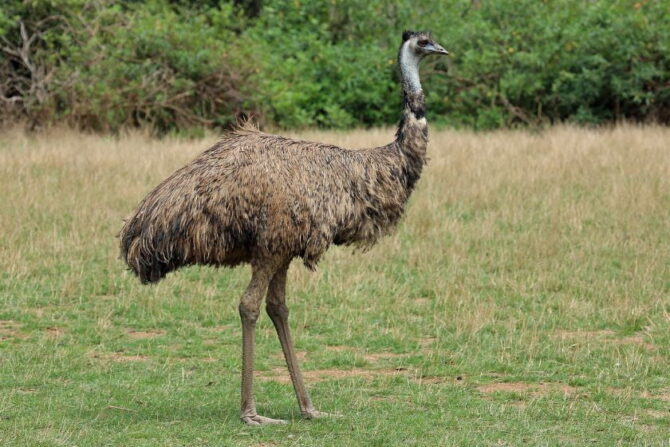
- Scientific Name: Dromaius novaehollandiae
- Size: 1.9 meters tall
- Range: Australia
- Habitat: Grasslands
- Diet: Omnivore
- Conservation Status: Least Concern
The emu is the second largest living bird, topped only by the ostrich that happens to be its relative. Both of them are ratite, and like the ostrich, the emu is a long-necked animal.
While some of the subspecies are extinct today, the emu is considered “least concern.” It inhabits grasslands in Australia.
Like the ostrich, emus can run fast, going up to 48 km/h. These birds are omnivores, feeding on both plants and animals. They do have a remarkable ability to not eat for weeks, and they need little water.
6. Greater Rhea
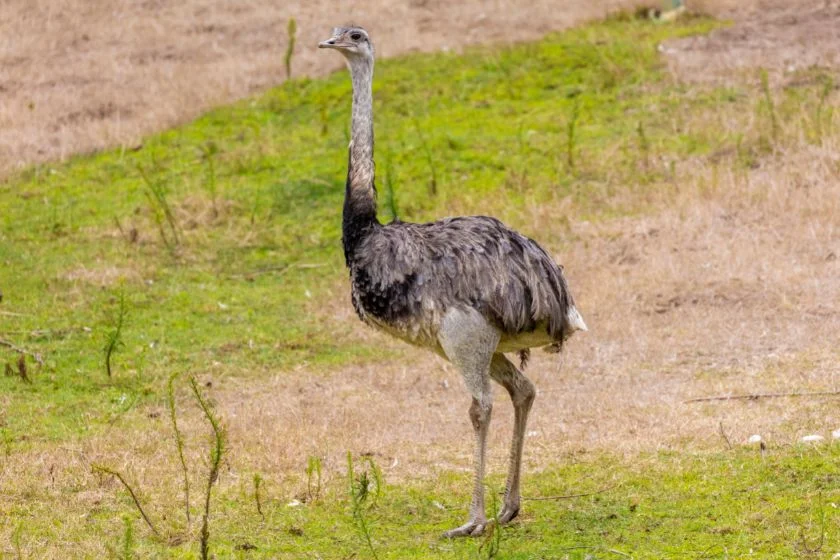
- Scientific Name: Rhea Americana
- Size: 44 to 60 pounds
- Range: South America
- Habitat: Grasslands, farmland, ranchland
- Diet: Omnivore
- Conservation Status: Near Threatened
The greater rhea is also named the grey rhea, the American rhea, the ñandù, or the ema. It looks similar to the ostrich as it is also flightless and it has a long neck.
The greater rhea is considered the biggest bird in South America where it lives. Due to population decline, these bird species are considered “near threatened.”
As an omnivorous bird, the greater rhea feeds on both plants and animals. The plant products include different fruits and seeds.
As for animals, the greater rhea preys on fish, insects, scorpions, rodents, reptiles, and birds.
7. Llama
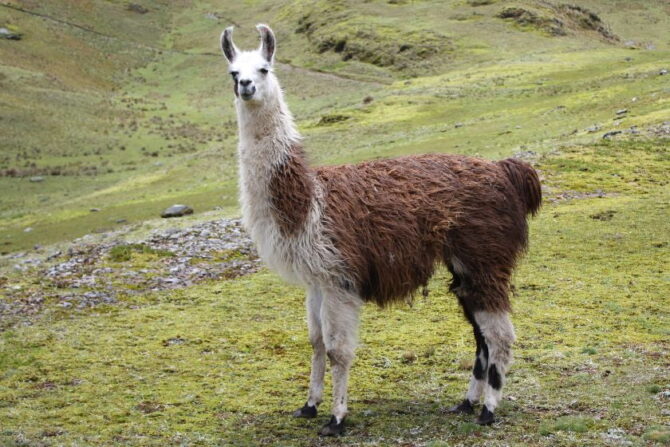
- Scientific Name: Lama glama
- Size: 5 feet 7 to 5 feet 11 inches, 287 to 600 pounds
- Range: South America
- Habitat: High plateau
- Diet: Herbivore
- Conservation Status: Domesticated
The llama is mainly found in South America, but it is also said to be in Europe, Australia, and North America. One of the distinguishing traits of this domestic animal is its long, fluffy neck.
The llama serves numerous purposes for humans, and it has been discovered to have antibodies. The neck helps it bend as it feeds on plants and also to see while it walks.
Llamas are social and friendly animals. That’s why they can live around humans as they have no aggressive bones in its body.
Instead, they will curiously try to approach people. However, if you spoil an adult llama, it will be unbearable to live with.
8. Black Swan
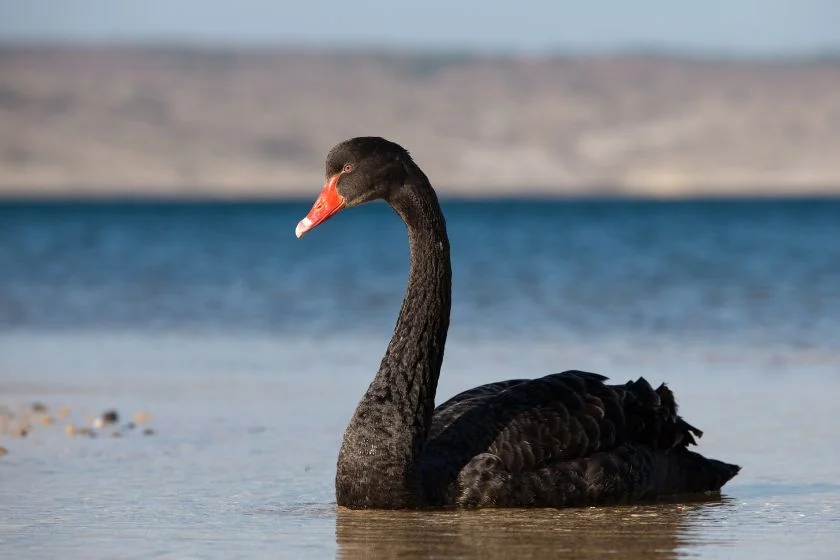
- Scientific Name: Cygnus atratus
- Size: 43 and 56 inches in length, 8 to 20 pounds
- Range: Australia
- Habitat: Fresh, brackish, saltwater lakes
- Diet: Herbivore
- Conservation Status: Least Concern
The black swan is found mainly in Australia, specifically in the southeast and southwest regions. It is large, has black feathers, a red bill, and a long neck.
It is considered “least concern,” and it is fully protected in Australia and should not be shot.
The black swan’s long neck is longer than any other swan, and it helps get to aquatic vegetation. It lives on waterbodies and is herbivorous. As such, it feeds on plants found around its surroundings and underwater.
9. Flamingo
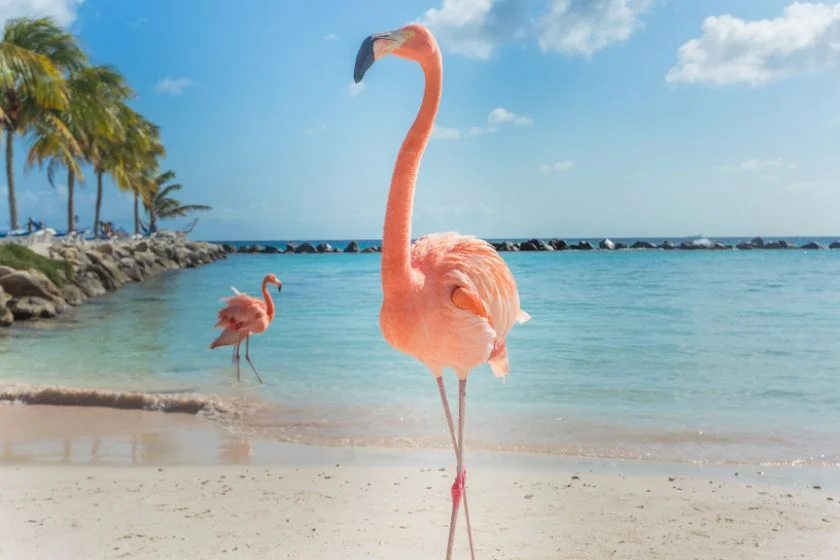
- Scientific Name: Phoenicopterus
- Size: 3.9 to 4.7 feet, 7.7 pounds
- Range: Americas
- Habitat: salt lakes and lagoons
- Diet: Omnivore
- Conservation Status: Least Concern
There are six flamingo species in today’s world. Four of them are located in the Americas (both North and South American continents) and the remaining two are in Africa and Europe. Its long neck stands out.
The flamingo has a good reputation in many places like the United States where pink plastic flamingoes are used for decoration and in the Bahamas where the flamingo is the national bird.
This bird feeds on algae, insect larvae, small insects, and crustaceans.
10. Great Egret
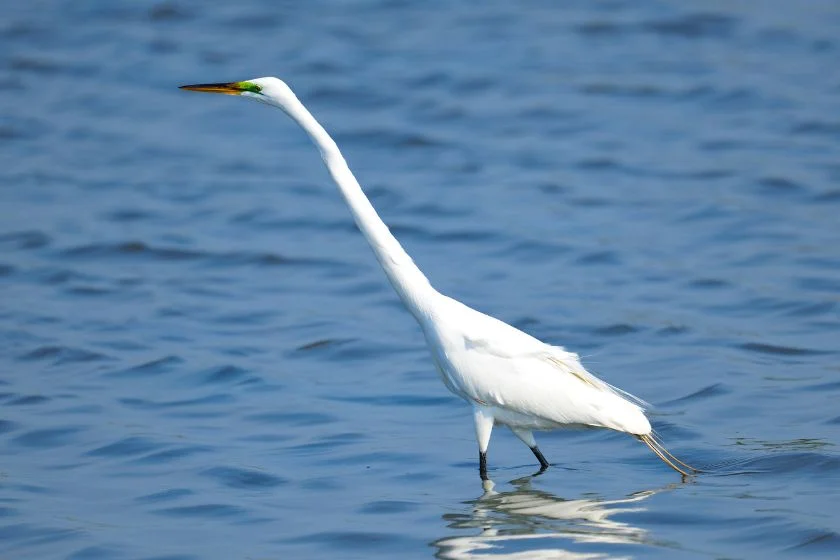
- Scientific Name: Adrea alba
- Size: 1m tall, 31 to 41 inches in length
- Range: Asia, Africa, Americas, and Europe
- Habitat: Marshes, ponds, shores, mud flats
- Diet: Carnivore
- Conservation Status: Least Concern
The great egret is also named the common egret, great white egret, large egret, and great white heron. It is popular and has a wide range, covering Africa, Asia, North and South America with Europe.
It is often seen close to waterbodies where it builds its nest. Also featured in the list of skinny animals, the great egret’s neck is the longest amongst egrets and can curve into an “S” shape.
The carnivorous egret preys on smaller animals, and its long neck serves as a hunting tool to pick up fish, frogs, reptiles, mammals, insects, and crustaceans. Its bill is like a spear that it uses to strike at the prey.
11. Snake-necked Turtles
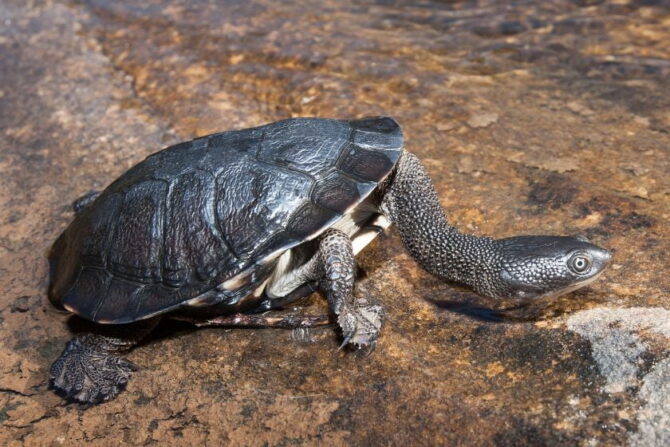
- Scientific Name: Chelodina
- Size: 18 inches in length
- Range: Australia, New Guinea
- Habitat: Stream, rivers
- Diet: Carnivores
- Conservation Status: Near Threatened
The snake-necked turtle is as unusual as its name. Unlike many other turtle species, it has a long, and snake-like neck.
Its neck is even longer than the shell, moving up to 25cm. It can be found in both Australia and New Guinea where it inhabits streams and rivers.
This turtle species is carnivorous, and it stays close to waterbodies so it can hunt down its primary prey—fish.
12. Dreadnoughtus Schrani
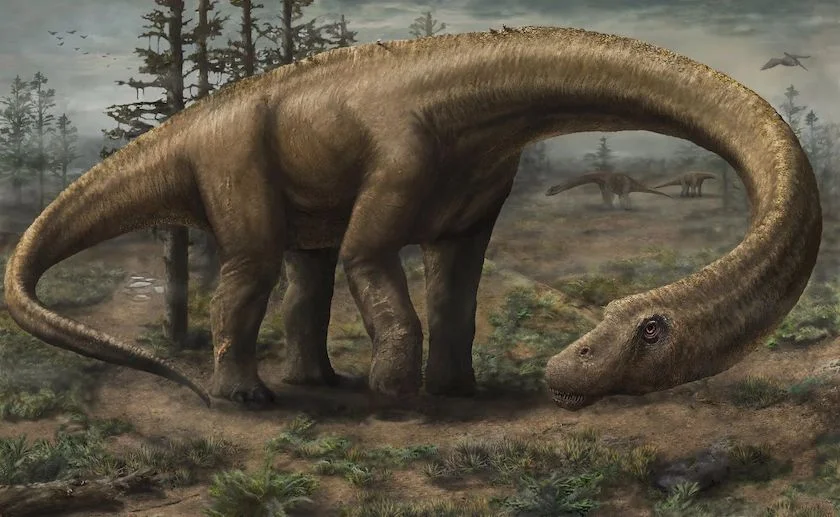
- Scientific Name: Dreadnoughtus schrani
- Size: 6m height
- Range: Argentina
- Diet: Herbivore
- Conservation Status: Extinct
The dreadnoughtus is a dinosaur, and we all know the unfortunate date of dinosaurs. According to discovery, it must have lived millions of years back during the Cretaceous Era.
A man named Kenneth Lacovara was credited with discovering the remains of the dreadnoughtus in Argentina where it must have lived. He also gave the name.
From the fossils, we know that the dreadnoughtus was a very huge land animal. It is considered one of the largest vertebrates that ever existed, and to complete that it had a very long neck.
The dreadnoughtus was possibly a herbivore, but still big enough to be feared.
13. Brachiosaurus Althitorax
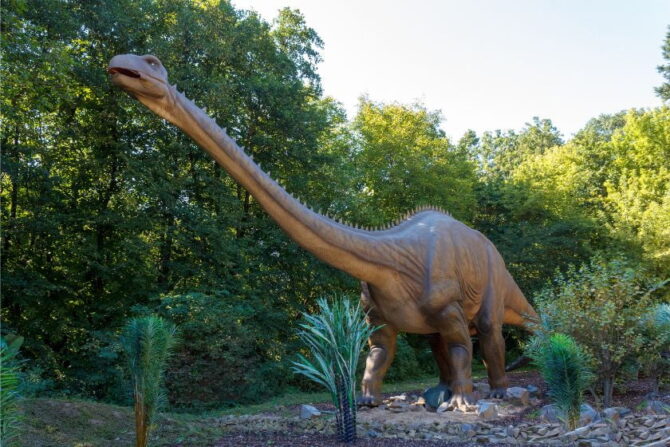
- Scientific Name: Brachiosaurus Althitorax
- Size: 18 and 21m long
- Range: North America
- Habitat: Prairies, conifer forests, groves
- Diet: Herbivore
- Conservation Status: Extinct
The brachiosaurus lived during the Jurassic years, dated 150 million years ago.
It existed even before the dreadnoughtus and was found in North America where it must have lived. It is also said to have stayed in Africa and Europe.
The brachiosaurus head alone is as long as a full snake, and its arms are long too. A brachiosaurus was featured in the popular 1993 film Jurassic Park.
From findings, the brachiosaurus is a herbivore, and one of the largest animals ever known. The neck measures up to 30 feet and curves in an S shape.
14. Diplodocus

- Scientific Name: Diplodocus longus
- Size: 80 feet long
- Range: North America
- Habitat: Meadows, forests
- Diet: Herbivore
- Conservation Status: Extinct
The diplodocus is the third dinosaur on our list which must have lived in North America. The fossils were discovered in 1877 by a man named Williston. It lived around 150 million years.
The diplodocus has both a long neck and a long tail, the latter is used against predators. The neck and tail both provided balance for the dinosaur.
The diplodocus was a herbivore, and the neck was an asset to getting to high branches.
Check out this list of 30 extant animals with long tails.
15. King Vulture
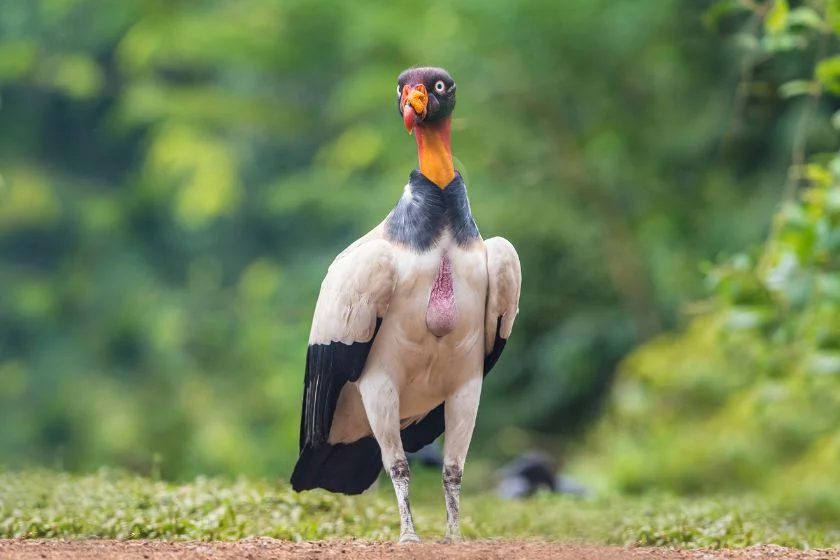
- Scientific Name: Sarcoramphus papa
- Size: 26 to 32 inches
- Range: Southern Mexico and Southern Argentina
- Habitat: tropical lowland forests
- Diet: Carnivores, scavengers
- Conservation Status: Least Concern
The king vulture can be found in Central and South America and is the only surviving member of its genus Sarcoramphus.
It inhabits tropical lowland forests and two major countries that host the king vulture are Mexico and Argentina.
The king vulture’s neck might not be as long as the animals we’ve seen so far, but it is relatively long compared to its body.
Like every other vulture, the king vulture is a scavenger. It feeds on dead animals ranging from fish to mammals. Cattle and lizards are some examples of animals it feeds on. It is depicted in some important human works.
16. Okapi
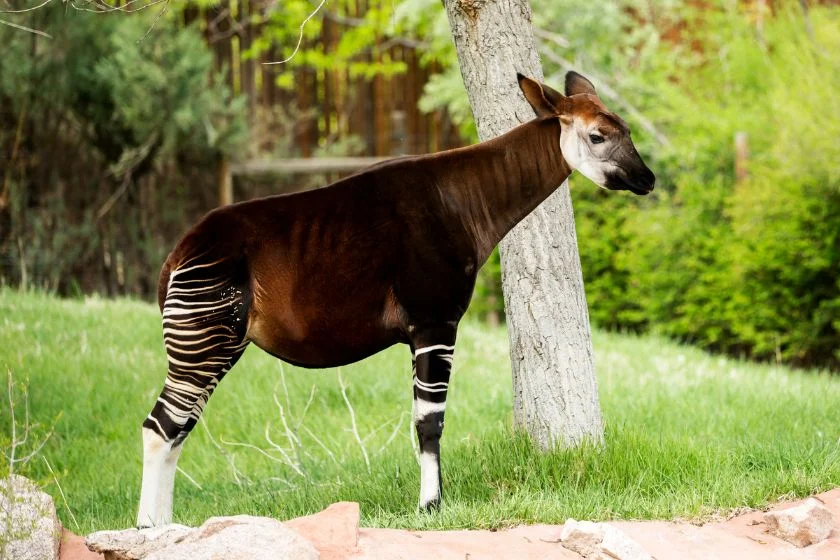
- Scientific Name: Okapia Johnstani
- Size: 1.5m tall, 2.5m long, 440 to 770 pounds
- Range: Africa
- Habitat: The Maiko National Park, rainforest, canopy forests
- Diet: Herbivore
- Conservation Status: Endangered
The okapi is also called the zebra giraffe, the Congolese giraffe, and the forest giraffe. It can only be found in the Democratic Republic of the Congo in Central Africa.
The okapi is similar to both the zebra and the giraffe, but it is more closely related to the giraffe than the zebra. Its neck isn’t as long as the giraffe’s, however, but it is long enough.
This animal feeds on tree leaves, grasses, buds, fruits, ferns, and fungi. It is diurnal, though some are known to be active at night.
Sadly, the okapi is now considered endangered due to numerous factors like habitat loss and hunting activities. The Congolese law fully protects the okapi.
17. Horse
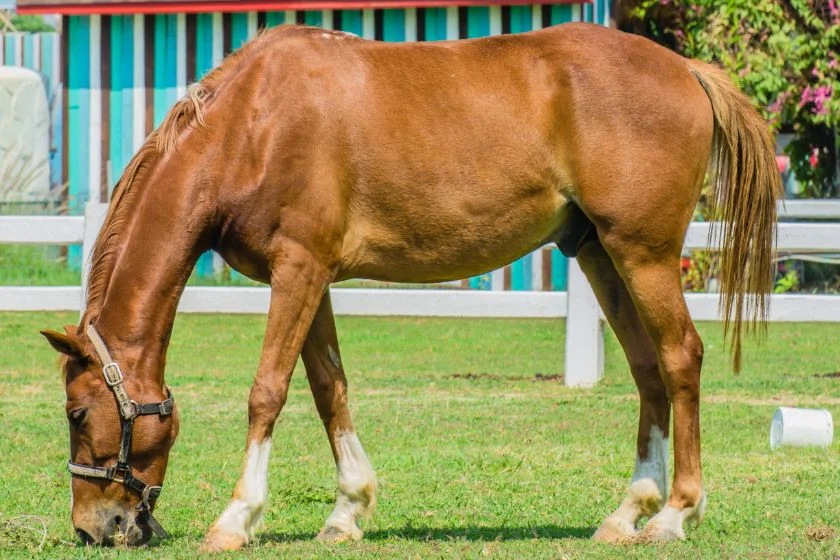
- Scientific Name: Equus ferus caballus
- Size: 2.4m in length, 1.4 to 1.7m in height, 300kg mass
- Range: Worldwide
- Habitat: Stable, prairies, steppes, plains
- Diet: Herbivore
- Conservation Status: Domesticated
The horse is a peculiar mammal that has been domesticated for years and now serves humans as farm animals, a transport system, for sports, and even as a pet.
There are wild horses that can be found on plains and prairies, but most of them are domestic. Horses can be found on every continent except Antarctica. They have big heads and long necks.
The horse is a herbivore and often feeds on plant products. Horses can be categorized into three types, based on temperament.
Hot-blooded horses have a lot of speed and endurance. The cold-blooded ones—like ponies—are slow and suited for heavy work. The third category is the warm-blooded horses that are crossed from the hot and cold ones.
18. Zebra
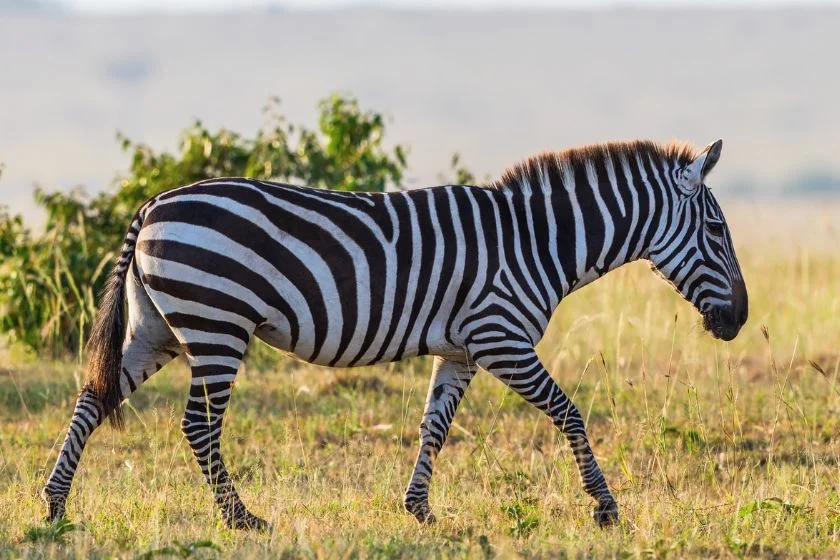
- Scientific Name: Hippotigris
- Size: 2.4 to 2.7m in lengths, 280kg to 400kg weight
- Range: Africa
- Habitat: Treeless grasslands, savannah woodlands
- Diet: Herbivores
- Conservation Status: Endangered, vulnerable, near threatened
The zebra is an easily recognizable mammal that looks like a donkey with stripes. There are currently 3 existing zebra species: the Grévy’s zebra, the plains zebra, and the mountain zebra.
Of all three, the plains zebra is the most common and is considered near threatened. The mountain zebra is vulnerable and the Grévy’s zebra is endangered. The zebra, like the horse, has a relatively long neck.
Various factors contribute to the zebra’s decline, the biggest of which is hunting for its skin and hides.
Notwithstanding, zebras have left an impact on human society and culture. Humans have even tried to domesticate the zebra, but attempts have been unsuccessful.
19. Komodo Dragon
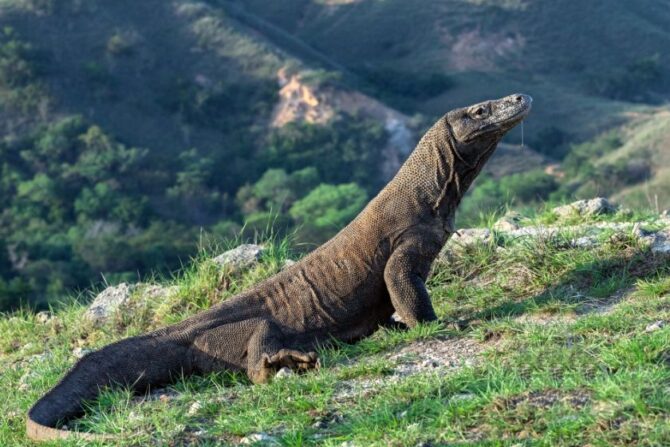
- Scientific Name: Varanus komodoensis
- Size: 10 feet in length, 150 pounds weight
- Range: Indonesia
- Habitat: Tropical savannah forests
- Diet: Carnivore
- Conservation Status: Endangered
The Komodo dragon also goes by the name Komodo monitor and can be found only on the Indonesian islands of Komodo (where the animal got its name), Flores, Rinca, and Gili Motang.
With a length of 10 feet and a weight of over 100 pounds, the Komodo dragon is the largest living lizard species. This species is similar to other lizards. It feeds on invertebrates, birds, and mammals.
Because of its size, the Komodo dragon is at the top of its food chain, making it an apex predator. It is currently endangered, which explains why its range is narrow.
20. Anhinga
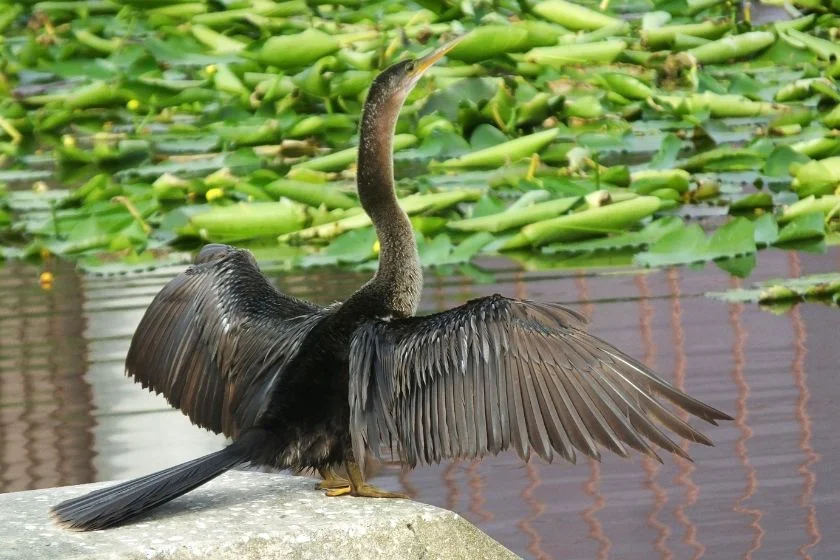
- Scientific Name: Anhinga Anhinga
- Size: 35 inches in length, 2.7 pounds in weight
- Range: Americas
- Habitat: shallow waters
- Diet: Carnivore
- Conservation Status: Least Concern
The Anhinga is a water bird that lives in the warmer parts of both American continents.
It inhabits shallow waters and is often seen swimming with its head above water, and because of its long neck, one would think it’s a snake. This trait earned it the name snakebird. It can also be called darter, American darter, and water turkey.
This bird is a stalking predator that goes after little water creatures like fish, crustaceans, and invertebrates. It uses its bill to spear the prey.
21. Alpaca
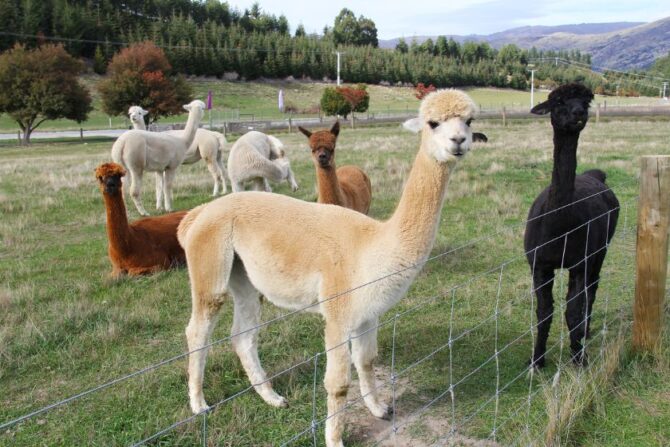
- Scientific Name: Lama Pacos
- Size: 32 to 39 inches in height, 106 and 198 pounds in weight
- Range: South America
- Habitat: Mountain
- Diet: Herbivore
- Conservation Status: Domesticated
The alpaca and the llama have a lot in common and are sometimes confused with each other.
However, they are different animals, and the alpaca is usually smaller in size. They are both long neck animals and can be cross-bred. The Alpaca lives in South America and has been domesticated.
Alpacas feed on hay, grass, and/or silage. They try to chew everything, so owners often keep food around on most occasions.
This animal is easy to take care of and train, though any potential owner should be aware of territorial behaviors. Alpacas move in herds too.
22. Jabirus
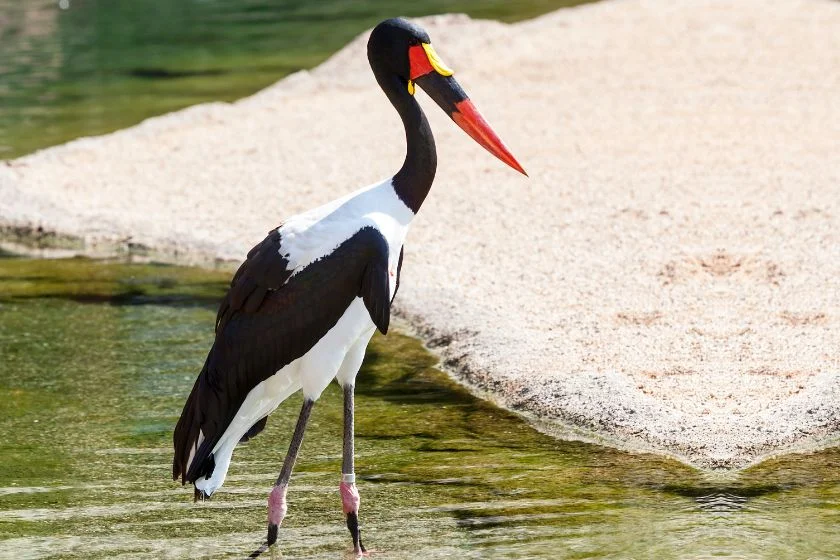
- Scientific Name: Jabiru mycteria
- Size: 47 to 55 inches long, 9.5 to 19.8 pounds
- Range: Americas
- Habitat: Savannas, coastal lagoons, and marshes
- Diet: Carnivore
- Conservation Status: Least Concern
The jabiru is a stork that can be found in different areas of both American continents, from Mexico to Argentina.
It can also be found in the United States, especially in Texas and occasionally in Mississippi. It’s the tallest flying bird in South America and Central America.
The jabiru’s name comes from a Turi-guarani language and it means “swollen neck”, pointing to how the jabiru’s neck is structured.
The male jabiru is widely different from the female and is also bigger. This animal feeds on fish, mollusks, insects, and other vertebrates.
23. Herons
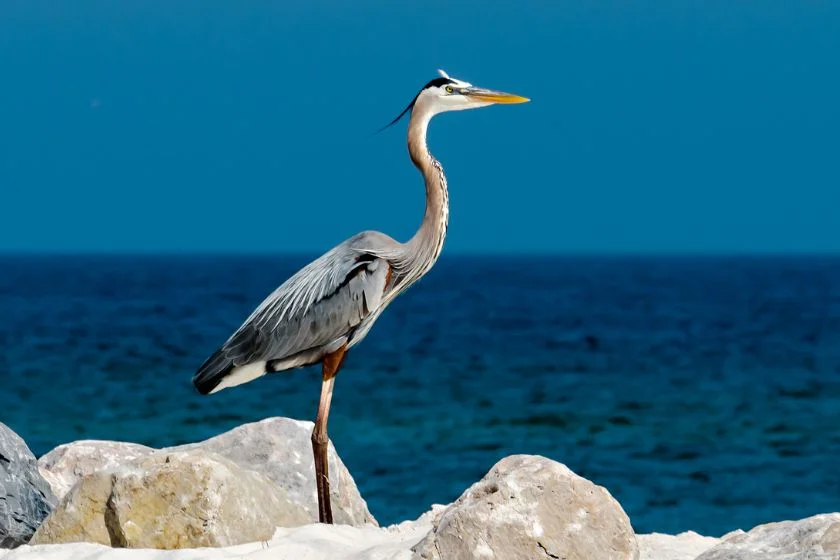
- Scientific Name: Ardea
- Size: 10 to 60 inches
- Range: Worldwide
- Habitat: All except artic regions, high mountains, and deserts
- Diet: Carnivore
- Conservation Status: Least Concern
A heron is a group of 64 bird species, all with similar traits of long legs and long necks. Not all these bird species are called herons, though. Some are referred to as egrets or bitterns.
Herons are often associated with other birds like storks, cranes, ibises, and spoonbills, but they distinguish from these birds by flying with their necks drawn back, not outstretched.
The heron’s size amongst member species ranges from 10 inches to 60 inches. These birds are carnivores, feeding on fish, amphibians, reptiles, mollusks, crustaceans, and aquatic insects.
Some also go for bigger prey, including other birds and rodents. A few have reportedly eaten plants, but that’s rare.
24. Scarlet Ibis
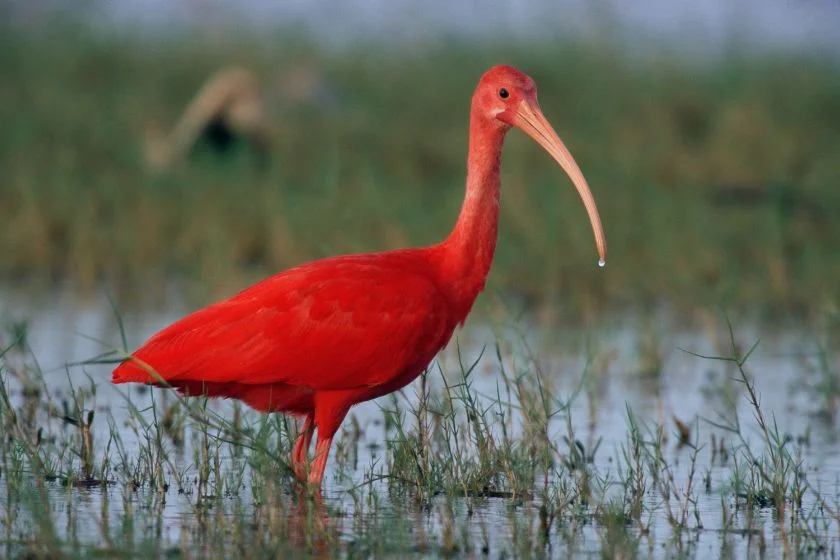
- Scientific Name: Eudocimus ruber
- Size: 22 to 25 inches long, 3.1 pounds
- Range: South America
- Habitat: Wetlands, mud flats, rainforests
- Diet: Carnivore
- Conservation Status: Least Concern
The scarlet ibis is often found in the South American continent, specifically in Brazil.
There are 27 other ibis species, but what sets the scarlet ibis apart is its color. They are among the birds with long necks with extended beaks.
The scarlet ibis often stays in pairs of twos during mating season on a nest built by both. The male has the responsibility of attracting the female using various tactics.
This bird is a carnivore that feeds on shrimps and many insects like ground beetles and scarabs.
25. Southern Cassowary
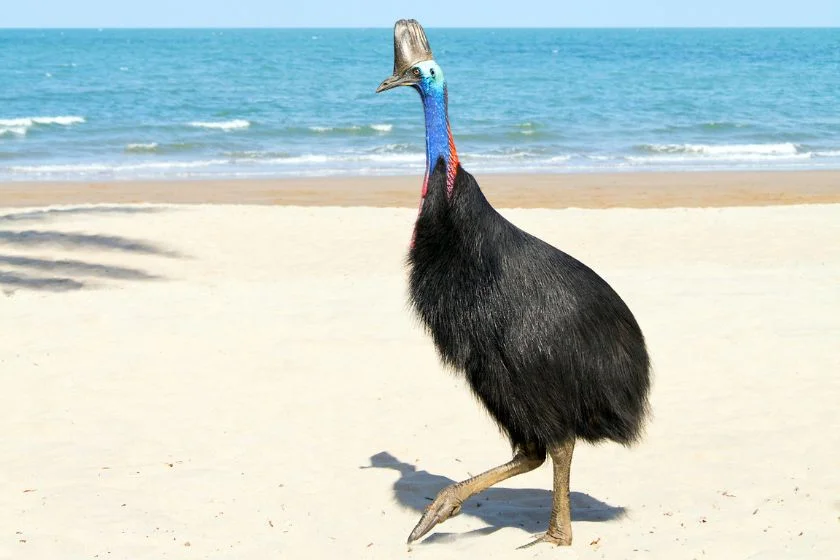
- Scientific Name: Casuarius casuarius
- Size: 7.0 inches
- Range: Australia, Papua New Guinea, Indonesia
- Habitat: Tropical rainforests, savannah forests, mangrove stands
- Diet: Omnivore
- Conservation Status: Least Concern
The southern cassowary can also be called the Australian cassowary, the two-wattled cassowary, and the double-wattled cassowary. It is a ratite bird, similar to the ostrich and the emu.
This means like these birds, the southern cassowary is large and can’t fly. It also comes with a long neck.
The southern cassowary forages for food in its forest habitat, feeding on fruits that it picks up.
It has the advantage of being able to eat toxic fruits that other animals can’t. This bird also feeds on fungi, small vertebrates, and insects.
26. Dorcas Gazelle

- Scientific Name: Gazella dorcas
- Size: 1.8 to 2.1 feet tall, 33 to 44 pounds
- Range: Africa, Arabia
- Habitat: Grassland, steppe, wadis
- Diet: Herbivore
- Conservation Status: Vulnerable
The Dorcas gazelle is one of our many gazelle species that resemble antelopes. It is also called the ariel gazelle, and it is a common one.
The Dorcas gazelle inhabits grasslands, steppes, wadis, and mountain deserts in Africa and Arabia. There’s an estimate of 35,000 to 40,000 Dorcas gazelles still alive.
Like other gazelles and antelopes, this species is a herbivore. It feeds on leaves, twigs, acacia trees, and fruits.
27. Common Crane
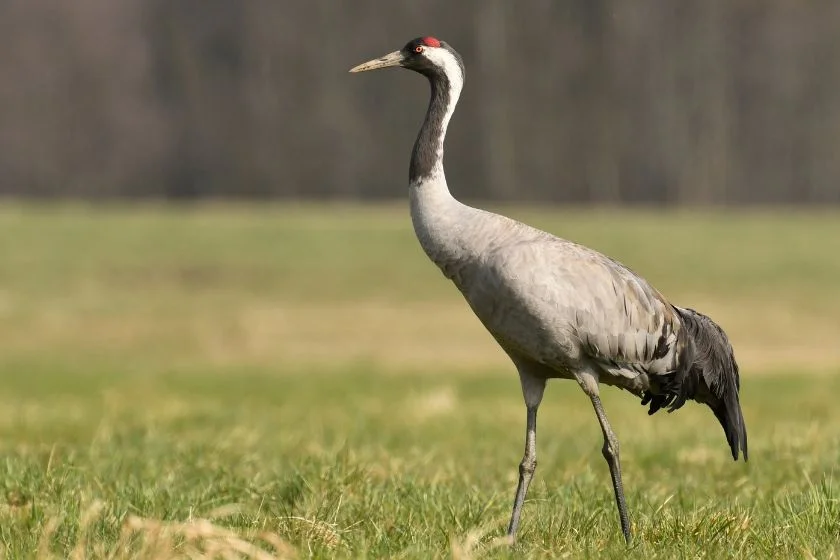
- Scientific Name: Grus grus
- Size: 39 to 51 inches long, 6.6 to 13.4 pounds
- Range: Europe, Siberia
- Habitat: Forests
- Diet: Omnivore
- Conservation Status: Least Concern
The common crane is called the Eurasian crane, a bird often found in Europe and also in Siberia. Of all the crane species, it is the only one not endangered or when threatened. The common crane is of least concern.
Cranes are similar to herons, but while herons hold their long necks back as they fly, cranes keep their necks outstretched.
The crane is an omnivore, eating both plants and animals. Its plant meal consists of roots, tubers, stems, leaves, fruits, and seeds.
Some animals the crane preys on include insects, snails, earthworms, spiders, crabs, and amphibians.
28. Mule Deer

- Scientific Name: Odoceilous heimonus
- Size: 31 to 42 inches in height, 3.6 to 6.9 feet in length
- Range: North America
- Habitat: Open grasslands, shrublands, mountain forests, semi-deserts
- Diet: Herbivore
- Conservation Status: Least Concern
The mule deer are found mainly in North America, and it was so named because of the ears that are similar to the mules’ own.
Its neck gets up to 13 inches, and though it looks like the antelope, the mule deer differs as it sheds antlers and grows new ones.
The mule deer (and other deer species in general), antelopes, and gazelles have a similar feeding pattern. They’re all herbivores and they graze fields, feeding on grass, shrubs, and other plants.
29. Great White Pelican
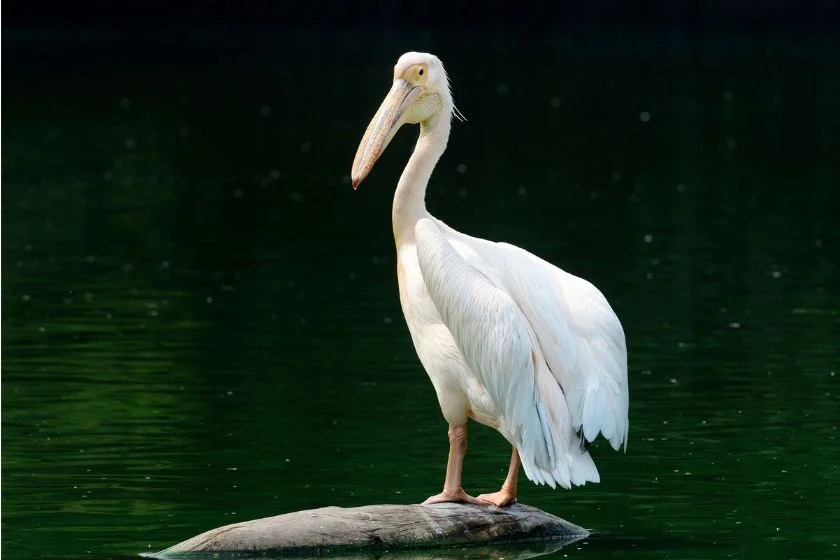
- Scientific Name: Pelecanus onocrotalus
- Size: 55 to 71 inches
- Range: Africa, Asia, Europe
- Habitat: Swamps, freshwater lakes, brackish lakes
- Diet: Carnivore
- Conservation Status: Least Concern
The great white pelican also goes by the names eastern white pelican, white pelican, or rosy pelican.
It is found in Europe, Asia, and Africa, specifically in countries like Nigeria, Ethiopia, Chad, Tanzania, Turkey, Greece, and Romania. It lives close to water bodies where it can find its main prey—fish.
The great white pelican is a carnivore, feeding mainly on fish. Its long neck and beak serve to grab any fish it sights while gliding over the waters.
Check out these lists of 30 animals that live in ponds and lakes.
30. Donkeys

- Scientific Name: Equus asinus
- Size: 35 inches to 59 inches
- Range: Africa, the Arabian peninsula, Middle East
- Habitat: Desert
- Diet: Herbivore
- Conservation Status: Domesticated
The last on our list of animals with long necks is the donkey, a more domestic relative of the zebra.
There have been some controversies as to whether the donkey is a subspecies of the African wild ass or a separate species of its own. For this article, we classified it as a separate species.
The domestication of the donkey began in Africa around 5,000 to 6,000 years ago, and from there, it moved to other parts of the world like the middle east and it became an invaluable asset for humans.
Final Thoughts
There are many long neck animals around the world and throughout time.
Some are related to themselves, some are extinct, some need to be protected and there are the safe ones.
We can also categorize them into domestic and wild animals. Overall, they each have a role to play in our environment and ecosystem.






